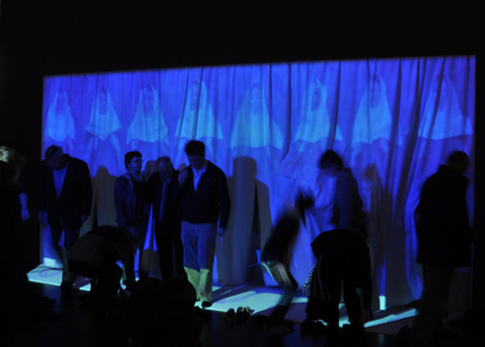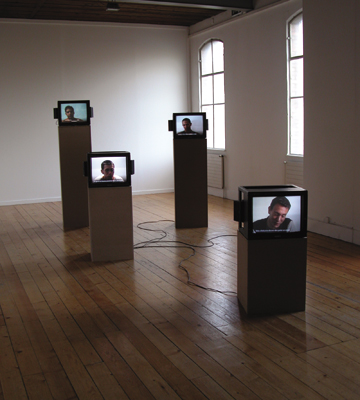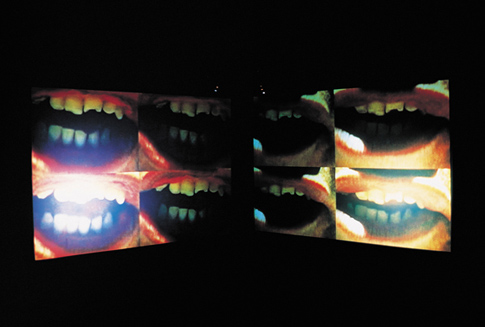
mΛmı, 2008
The exterior projection of mΛmı shows eight young women in Iranian school uniforms standing in a row before a blue backdrop. They slowly close their eyes and dissolve into the blue of the curtain. The rocking chair in the interior is a play on an unadorned "throne," and the television set shows a 6-year-old professional mourner weeping bitterly. mΛmı reflects the role of the media, television in particular; how it has in general, and in a motherly way, substituted religion and particularly the Pastor, and how religion, once considered as "the opium of the masses", has become the opium of a religious media-based state and its masses. The Persian word for curtain, pardé, carries equally the meanings of screen, hymen and shroud. The blue pardé refers both to the blue box technique and various mise-en-scènes used in Iran's political visual system of representation.
The installation mΛmı is oriented towards Mecca.
Barbad Golshiri, * 1982 in Tehran (IR), lives and works in Tehran (IR)

Barbad Golshiri, mΛmı, 2008
video installation (colour, sound), mixed media
dimensions and runtime variable
From 'Odyssey-i project'
courtesy Barbad Golshiri
produced in cooperation with
ZKM | Center for Art and Media Karlsruhe
|

A Tank Translated, 2002
On four monitors, the installation shows interviews with Israeli soldiers from a tank crew. The monitors are, analogous to the positions of the soldiers in the tank, set up at various heights. The soldiers describe their respective personal state while going into action in an armoured vehicle. Omer Fast intervenes in the documentary character of the interview by manipulating the subtitles. Military expressions shift into civilian ones, individual words disappear completely and statements are turned around into their contrary. The work shows, on one hand, the conflict between a task ordered by the state and civilian principles. On the other, it enquires into the boundary between a private mission and a state-ordered one and the way public media present truth.

CNN Concatenated, 2002
CNN Concatenated is a compilation by Omar Fast from a database of 10,000 words and clips into a speech put together from individual words spoken by different news anchors. In contrast to the profusion of daily news, the artist attempts here to close the gap between the necessity to know and to understand, and the desire to see and to experience, and so provides a consistent context from which the information gains coherence of meaning. Community, intimacy and a collective memory are created here, action and escape appear possible. The common language also forms the basis for a common framework for action.
Omer Fast, * 1972 in Jerusalem (IL), lives and works in Berlin (D)
 Omer Fast, A Tank Translated, 2002 Omer Fast, A Tank Translated, 2002
4-channel video installation (colour, sound)
German subtitles
installation view Fribourg Kunsthalle
courtesy gb agency, Paris
Omer Fast, CNN Concatenated, 2002
video (colour, sound)
18 min., loop
courtesy gb agency, Paris
|
|

Das Unsagbare Sagen, 1992
Valie Export's numerous films, videos, performances and her work as a curator bear out this Austrian artist's genre-spanning pursuits. In the early 1990s, she collaborated with Oswald and Ingrid Wiener in the documentary Das Unsagbare Sagen, placing at its centre forms of articulation far removed from any linguistic structure or norms. The piece shows, among others, aphatic speakers, sound poets and small children, while the extract presented here is devoted to the phenomenon of glossolalia, or speaking in tongues, that is speaking without intelligible meaning. This religious practise was already mentioned as a sign of belief in the New Testament and is today practised mainly by Christian Pentecostalism.
Valie Export, * 1940 in Linz (AT), lives and works in Cologne (D) and Vienna (AT)
Ingrid Wiener, * 1942 in Vienna (AT), Oswald Wiener, * 1935 in Vienna (AT).
Live and work in Vienna (AT)
 VALIE EXPORT, INGRID and OSWALD WIENER, Das Unsagbare Sagen, 1992 VALIE EXPORT, INGRID and OSWALD WIENER, Das Unsagbare Sagen, 1992
video (colour, sound), 45 min., extract of 12:50 min.
Script: OSWALD WIENER
Direction and Design: VALIE EXPORT, INGRID and OSWALD WIENER
Camera: VALIE EXPORT and INGRID WIENER
Sound: OSWALD WIENER
Editor: Heinrich Mis
Production: P.R.E.TV
on behalf of ORF /Kunststücke
|

Deus é boca [Gott ist Mund], 2002
In their works, Dias & Riedweg often address perceptions of what is private and what is public. Their video installations transit between the fine arts and performance art. The yearning after belief and religious observation is generally stronger than the suffering caused by a lack of information and material resources, and yet, the idea of God has always been something the individual needs, irrespective of their relationship to the state. The piece Deus é boca deals with how this personal need is manipulated by state interests, and it creates a poetic visualization of the power of discourse: mouths that talk and their eager listeners, searching for something they can believe in. What does a funk musician's mouth have in common with that of a frenetic preacher? And the mouth of a starved street vendor with that of a politician courting favours?
Mauricio Dias, *1964 in Rio de Janeiro (BR)
Walter Riedweg, *1955 in Luzern (CH), live and work in Rio de Janeiro (BR)

Dias & Riedweg, Deus é boca [Gott ist Mund], 2002
4-channel video installation (colour, sound)
© Dias & Riedweg, 2002
courtesy of Galeria Vermelho, São Paulo and Galeria Filomena Soares, Lisboa
|
|



